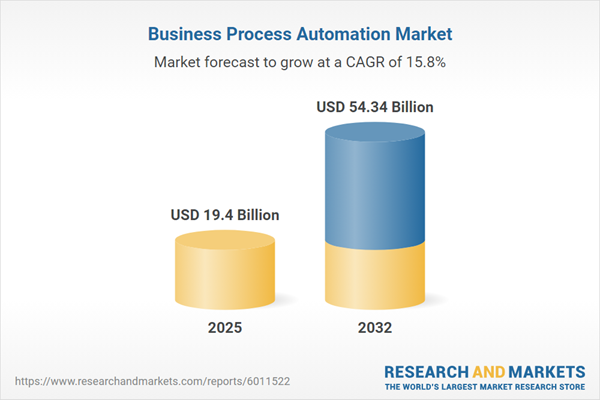Speak directly to the analyst to clarify any post sales queries you may have.
Business process automation is becoming essential for organizations aiming to streamline operations and boost agility amid rising competitive pressure. Senior executives are increasingly prioritizing automation not only for cost control, but also to unlock real-time insights and maintain process reliability at scale. This report offers a clear analysis of the business process automation market, addressing evolving technology and regulatory dynamics for informed decision-making.
Market Snapshot: Business Process Automation Market Size and Growth
The Business Process Automation Market grew from USD 16.77 billion in 2024 to USD 19.40 billion in 2025. It is expected to continue growing at a CAGR of 15.83%, reaching USD 54.34 billion by 2032. Automation has moved beyond basic workflow digitization, emerging as a principal driver of efficiency, especially as cloud platforms and artificial intelligence are integrated into enterprise processes. Industry adoption is broadening as organizations leverage scalable automation solutions to adapt to hybrid work models, complex compliance requirements, and the demand for continuous service delivery.
Scope & Segmentation of the Business Process Automation Market
- Component: Hardware, Services, Software
- Organization Size: Large Enterprises, Small and Medium Enterprises
- Deployment Type: Cloud, On Premises
- Application: Analytics & Monitoring, Document Management (Capture, Retrieval, Storage), Robotic Process Automation, Workflow Management
- Business Function: Customer Service, Finance and Accounting, Human Resources, Procurement and Supply Chain
- End User Industry: Banking and Finance, Healthcare, IT and Telecom, Manufacturing, Retail and E Commerce
- Regions: Americas (North America: United States, Canada, Mexico; Latin America: Brazil, Argentina, Chile, Colombia, Peru), EMEA (Europe: United Kingdom, Germany, France, Russia, Italy, Spain, Netherlands, Sweden, Poland, Switzerland; Middle East: United Arab Emirates, Saudi Arabia, Qatar, Turkey, Israel; Africa: South Africa, Nigeria, Egypt, Kenya), Asia-Pacific (China, India, Japan, Australia, South Korea, Indonesia, Thailand, Malaysia, Singapore, Taiwan)
- Key Vendors: UiPath Inc., Automation Anywhere Inc., Microsoft Corporation, Blue Prism Limited, NICE Ltd., Pegasystems Inc., International Business Machines Corporation, SAP SE, Kofax Inc., Appian Corporation
Key Takeaways for Business Process Automation Strategy
- Adoption of business process automation is being catalyzed by advances in cloud computing, AI, and low-code/no-code platforms, enabling organizations to rapidly scale and customize automation without heavy IT overhead.
- Hybrid and remote work trends are pushing enterprises to prioritize scalable automation frameworks that maintain process integrity and incorporate audit-ready controls for regulatory compliance.
- Empowering employee productivity by automating repetitive tasks supports innovation and higher-value work, which is critically important as skills shortages persist across industries.
- Industry-specific factors, such as healthcare data security or financial sector compliance, drive unique automation requirements and add complexity to deployment and integration decisions.
- Collaborative ecosystems, fostered through strategic partnerships, M&A, and open architecture, are shaping vendor differentiation and delivering more adaptable automation suites.
Tariff Impact: Navigating US Trade Policy in Automation Supply Chains
In 2025, new US tariffs are affecting automation hardware supply chains and shifting procurement strategies. Manufacturers face higher import duties, prompting diversification of suppliers, renegotiation of contracts, and increased focus on localized assembly. Service and software vendors are adapting license models and product deployment timelines in response, while some enterprises are accelerating cloud solutions to reduce direct reliance on hardware. These regulatory changes are influencing both short-term spending and long-term technology sourcing decisions for automation leaders.
Methodology & Data Sources
This report integrates both primary and secondary research methodologies. It draws insights from interviews with senior executives, surveys, and in-depth analysis of public data, industry reports, regulatory filings, and vendor whitepapers. Data triangulation, expert peer reviews, and validation workshops ensure all findings are accurate and actionable.
Why This Report Matters for Decision-Makers
- Provides detailed market analysis and segmentation to support strategic planning and identify areas for targeted automation investment.
- Highlights technology and regulatory trends, allowing leaders to anticipate operational challenges and benchmark best practices in process automation.
- Delivers actionable recommendations to accelerate adoption, optimize process performance, and secure competitive advantage in a rapidly transforming market.
Conclusion
This executive summary presents a current view of business process automation, offering strategic insights on technology, operations, and regulatory developments. Leaders can apply these findings to shape robust, future-focused automation initiatives that drive measurable value across business functions.
Additional Product Information:
- Purchase of this report includes 1 year online access with quarterly updates.
- This report can be updated on request. Please contact our Customer Experience team using the Ask a Question widget on our website.
Table of Contents
3. Executive Summary
4. Market Overview
7. Cumulative Impact of Artificial Intelligence 2025
List of Figures
Samples

LOADING...
Companies Mentioned
The key companies profiled in this Business Process Automation market report include:- UiPath Inc.
- Automation Anywhere Inc.
- Microsoft Corporation
- Blue Prism Limited
- NICE Ltd.
- Pegasystems Inc.
- International Business Machines Corporation
- SAP SE
- Kofax Inc.
- Appian Corporation
Table Information
| Report Attribute | Details |
|---|---|
| No. of Pages | 183 |
| Published | October 2025 |
| Forecast Period | 2025 - 2032 |
| Estimated Market Value ( USD | $ 19.4 Billion |
| Forecasted Market Value ( USD | $ 54.34 Billion |
| Compound Annual Growth Rate | 15.8% |
| Regions Covered | Global |
| No. of Companies Mentioned | 11 |









